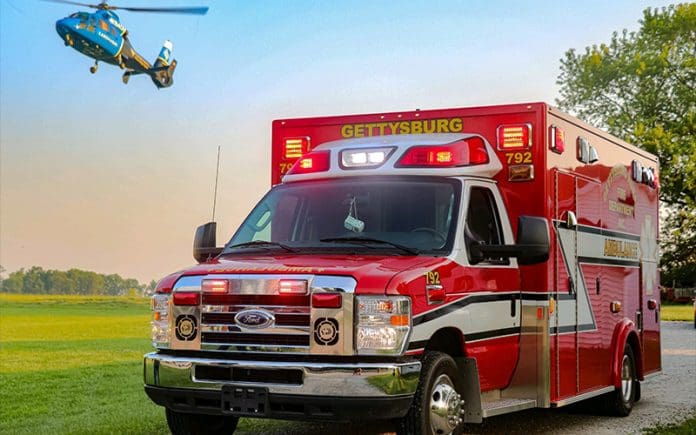DARKE COUNTY – Speeding traffic causing safety concerns around Fire and EMS scenes is a growing problem. While firefighters and EMTs should be worried about helping patients and victims, they must also be highly concerned about civilian traffic.
When a first responder arrives on a scene, their first priority is the patient. Whether it’s a victim of a car accident, a fire, or another emergency, the main priority is taking care of them. Unfortunately, a continuously growing problem is civilians ignoring lights, sirens, and emergency scenes altogether, speeding past and causing serious safety concerns.
“When we first get there, traffic control is not our main priority,” Gettysburg Rural Fire Department Chief Tom Hill said. “Our first priority is the patient. We don’t start traffic control until everything else is all done. So you’ve got that first 10, 15, 20 minutes that’s a free-for-all. They just need to learn to be courteous.”
This is an especially big concern on state routes, such as 36 or 127, and out on rural roads, where the speed limit is faster.
“The roads and highways in the county outside in the rural areas have speed limits of 55, and the reality is most people aren’t going 55,” Darke County Sheriff Mark Whittaker said. “They are going anywhere from 5 to 10 miles per hour faster.”
With firefighters and EMTs focusing on the scene and going back and forth between the scene and their trucks for tools, cars speeding past and not paying attention is a serious danger. One wrong step or minor mistake could lead to a first responder getting seriously injured or killed.
This is less of a problem in cities like Greenville. Not only are speed limits much slower in town, not going over 35 miles per hour, but they also have the city police right on the scene with first responders to help and take care of traffic for them.
“We’ll position our vehicles to try to give us a safe area so if someone tries to come through more likely it’ll hit the fire truck and not us or the patients that are involved,” Greenville Fire Department Chief Russell Thompson said. “For the most part, we are triaging patients along with Greenville rescue personnel; if we have fuel leaks and stuff like that, we are mitigating that stuff. Our police officers do a great job; their concentration is, of course, investigating the accident, but they do a really good job of redirecting the traffic for us; we don’t typically do that.”
Rural stations aren’t so lucky. Without city police right behind the first responders, rural stations have to wait for sheriff deputies to arrive to start directing traffic.
Rural stations are also mostly volunteer-based and short-staffed. They don’t have the spare responders to do traffic control to make sure everyone else on the scene doesn’t get hit.
“It can be aggravating because you’re trying to worry about your guys’ safety and what’s going on,” Gettysburg Rural Fire Department Lieutenant Josh Boehringer said. “For a person in Tom’s position, my position, somebody that’s in charge of a scene, the number one thing is the safety of the guys and the safety of the scene.”
Chief Hill, Chief Thompson, and Sheriff Whittaker shared instances where a car driving through a scene caused safety concerns and issues.
“We get on a car wreck on 36,” Chief Hill said. “We’ve got guys out there flagging people down, trying to get them to stop, and they just drive through going 70 mph. Even with the red lights flashing on the fire trucks, nobody wants to slow down.”
“We’ve had where we are trying to land a helicopter, and it’s completely shut down, and the next thing you know, we have a drunk driver that’s weaving its way through all the cars and everything,” Chief Thompson said. “That’s actually happened multiple times throughout my career.”
“We had a traffic crash on 127 and Children’s Home Bradford Road a couple of months ago,” Sheriff Whittaker said. “We had an intoxicated person drive right into the sign right in the middle where the crash was. Of course, that person was arrested and taken to jail. But at that same scene, I had multiple cars driving around police cruisers with flashing lights blocking the roads. It’s clear you can’t come through here. It’s blocked, and they just drive around the cars, and it’s a mentality that you’re not going to stop me from going where I’m going. I’m just going to do what I want. When I interact, or I stop these folks, that’s what I’m finding.”
The leading cause of this growing issue seems to be a combination of distracted driving and a lack of patience. Drivers are distracted by their phones, music loud enough that they can’t hear sirens, and screens throughout the car that take up attention. Drivers also seem to lack patience, having a general need to hurry and a focus on getting where they think they need to be without being delayed.
Sheriff Whittaker mentioned a few laws that drivers can be cited for when driving dangerously through a Fire or EMS scene.
“So if somebody arrives at an emergency scene, and they’re misbehaving and they’re not acting appropriately, and they don’t leave and they’re causing issues, then they can be arrested a criminal charge called misconduct at an emergency,” Sheriff Whittaker said. “If they come speeding through a scene, that’s going to be a speed violation. Under speeding, there’s kind of a catch-all speed violation, which basically means you’re speeding for the conditions. There’s also not following the lawful order of a police officer. So if I’m saying stop, slow down, and they are ignoring that, that’s failure to comply.”
While the idea may not be popular, it’s been agreed that the best way to keep everyone safe at an emergency scene is to shut down the road entirely rather than leave a lane open. This may cause an inconvenience for citizens, but it’s the only way that they can keep the scene, the patients, and their responders as safe as possible.
Chief Thompson, Chief Hill, and Sheriff Whittaker all shared that when approaching any fire or EMS scene, you need to stop and wait for directions from first responders to ensure you get through safely.
“The best thing to do is just stop and wait for someone to direct you through,” Chief Hill said. If that takes ten or fifteen minutes, then I’d sit there until someone directs me through.”
“I recommend you slow down and prepare to come to a stop until you get closer to that scene and then take directions from hopefully law enforcement or the first responder directing it,” Chief Thompson said.
“First, if you see flashing lights of any kind, yellow, red, blue, I don’t care what they are, start slowing down,” Sheriff Whittaker said. “When you approach the scene, if you see vehicles are crossing the roadway or in the roadway you need to slow down and stop. You don’t do anything until you know for sure, and maybe you look for direction. More often than not, we will direct. Now, that doesn’t happen all the time. If you see a vehicle that is crossing your lane of travel, you need to stop and not proceed any further, and you need to consider another route at that point. Just because the opposite lane is open or isn’t completely blocked doesn’t mean it’s okay to go around. You should never be driving around any emergency equipment in the roadway unless you are directed by an emergency official. You need to stop, probably turn around, or just wait until you are given proper direction.”
So pay attention while driving. When you see lights and sirens behind you, slow down and pull off to the right. If you approach a fire or EMS scene, stop and wait for instruction. It’s the best way to keep yourself, the patients, and the first responders safe.








